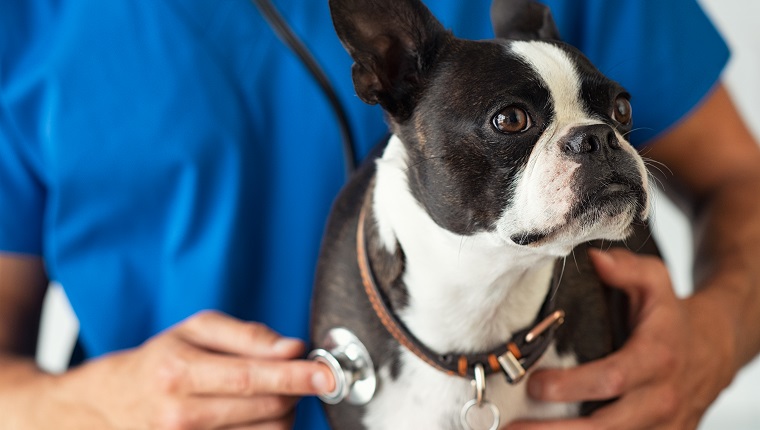As pet parents, we try to give our dogs the happiest, healthiest, and longest lives we can. That’s why new advancements in medicine and treatments for our dogs can give us so much hope!
Better and more modern vet care means our pups can spend a lot more loving years with us!
In between her time spent treating patients at Chicago Exotics in Skokie, IL, working as Vice President of the North American Veterinary Community (NAVC), and enjoying her own dogs, Dr. Dana Varble, DVM, graciously offered to share her passion about modern veterinary medicine with DogTime for an interview.
AMANDA: Thank you so much for sitting down with us for an interview. I’m excited to hear about the latest and greatest in the veterinary world.
DR. VARBLE: You’re welcome! As a veterinarian, an officer for the NAVC, and a dog owner, myself, I’m always striving to learn the best techniques for caring for our four-legged companions and sharing that information.
AMANDA: Wonderful! Let’s get started.
How Do You Know When A Dog Is In Pain?
AMANDA: Something frustrating and frightening for me as a dog owner is my dog not being able to tell me what’s wrong. How do you “communicate” with dogs to figure out sources and causes of pain?
DR. VARBLE: As a pet owner, that’s the scariest thing. All the logic and training goes out the window when it’s your pet. It’s emotional to us when something’s not quite right.
We use a combination of the skills we learned (both in and out of [veterinary] school) to feel if things are wrong. In school, they really stress the importance of a physical exam. The longer you’re out of school, the more you appreciate that!
Telemedicine is very cool, but there’s nothing like our being able to put our hands on an animal and feel things. We know what normal dog teeth, rib cages, backs feel like. A physical exam is the biggest first clue on an ailment. I might do an X-ray later, but I won’t know where to do it without that exam—same goes for a blood test, etc.
We do rely really heavily on dog owners. They’re the ones with the dogs 24 hours a day.
They could be subtle signs—they’re eating slower, they’re walking differently, or they won’t go up the stairs—those little changes really do mean a lot.
For instance, I know a dog resisting or having trouble walking up and down the stairs means it might be sore, have a subtle limp, or have neck or back pain.
Neck and back pain is a common problem in dogs, and the signs are really subtle, but I have to have my hands on the dog to tell what’s going on. Once I do have my hands on the dog—I can almost always tell what’s wrong. When you push on each vertebrae in the way we’re trained, it tells you a lot.
Vets look differently than owners do, but owners can tell when there’s a change. It’s really important that owners realize they’re part of a care team. We’re all working together. We need you as much as you need us!
AMANDA: That is reassuring to hear!
What’s New In Vet Care?
AMANDA: How would you say veterinary medicine has changed in the last ten to 20 years?
DR. VARBLE: A lot has changed, actually, both in diagnostic capabilities and even humans’ relationships with their pets. Digital X-rays are a big advancement—almost every vet has one now. They tell us so much more than old film X-rays could.
The idea of performing a CT on small animals was almost unheard of 16 years ago. They used to be the size of a house. Now they’re the size of a washing machine!
Size and cost are coming down, which means a lot more specialty hospitals have them. A CT scan is a lot more accessible to pet owners now.
Ultrasound machines are another great example. They used to be the size of a washing machine, but now, some are the size of a laptop. There’s even one in development to be a smartphone attachment. That means even small clinics can fit one in, and as a smartphone attachment, many more can afford it. A screening ultrasound at every office would be such a great tool! They can tell us a lot.
We used to have to send blood work out to a lab to get analyzed, but blood analyzers are smaller, more specialized, more accessible now.
The bottom line is we’re getting results more quickly and accurately, and we have a lot more tools available to us. We’re able to do a lot more screening right in the clinic. I’m really excited about this because it means better care for our pets.
Better Vet Care And Better Pet Parents Work Together!
DR. VARBLE: Dogs and cats are living longer—even within the last 20 years. Stats show lives are at least one year longer. We love getting pets to the vet more often; every six months is not unheard of. We want to catch more, and we can, with more frequent visits.
We have so many more options for treatments. Catching problems earlier actually does keep costs down.
It’s not just about extending to a longer life, but promoting a better quality of life. That goes for all animals.
As society has changed, we see pet ownership change—more people are getting pets. About ten years ago, the fastest-growing pet ownership was turtles and tortoises, because we know so much more now about how to take care of them. The more we know, the more accessible pet ownership is. We’re learning more about how to keep more types of animals.
We also know more and more about how important the human-animal bond is—at the NAVC Institute, we study that bond a lot. We know it’s important for human health and pet health, and we really want to enhance that part of your life.
Let’s keep your dog happy and healthy, exercising, playing, snuggling with you—a really significant part of your life—as long as we can. It’s been really important to see that part of human-animal interaction grow and change.
A lot of people even sleep with their dogs on the beds now—things like flea and parasite control are so much better, and it can increase the bond. That flea, tick, and heartworm medication is so important because we don’t want our dogs getting it or passing it onto us.
As people have become more bonded to their pets, we know they’re seeking more vet care—and it’s been wonderful to be able to stop problems earlier.
AMANDA: That’s wonderful to hear!
Are Dog And Human Medicine Linked?
AMANDA: Speaking of mutual health benefits–would you say dog and human medicine have influenced each other at all?
DR. VARBLE: They’ve advanced very much in tandem.
The most common cancers in dogs and cats are not the most common cancers in humans. There’s a lot of crossover in drug development, but some is very specific, like dog lymphoma. However, much of the overlap there is–how do we train the autoimmune system to target cancer cells, regardless of type?
There’s also a lot of theoretical stuff going on out there that is exciting–more to come on that. Oncology is one of the things that I think will change dramatically over the next ten years.
I have so many speakers presenting these topics at our NAVC conferences, on our online learning platforms, etc. We’re really about bringing expert speakers to these platforms, so vets are learning about these things as they’re coming out.
AMANDA: That sounds like a great resource!
Different Medicine For Different Dogs
AMANDA: How do you feel about more extreme treatments for dogs, like chemotherapy or insulin injections? When and how do you decide if it’s right for a dog?
DR. VARBLE: If a dog is on insulin, they usually have diabetes. The needles are tiny. It’s a disease that can be managed fairly easily. But there are some dogs out there who have a lot of stress and anxiety, and that kind of treatment just doesn’t work for them.
But there are alternatives out there, and some oral medications are being developed that also work. Every dog is different in what they’ll tolerate.
Some dogs feel like acupuncture is a spa appointment—they get petted, they feel great—but some are too anxious. That’s why your vet is such an important part of your care team—not everything is right for every dog. You can figure it out together.
The biggest hurdle for dog owners to get over is—when we do chemotherapy on people, it’s usually to cure their cancer. It’s very aggressive, and side effects can be common and severe.
The goal of chemo with people is very different than the goal with a dog.
Occasionally, it’s the same goal to cure the cancer in a dog. But usually, the goal is not to cure them, but to make them better. It may not be treating it completely, but just minimizing/managing the cancer, so they don’t feel the cancer.
That means it’s a lower dose, not as severe of chemo treatment. That means a lot of dogs tolerate it very well—they have minimal side effects, maybe just a bit of GI upset.
It’s not about keeping them in the hospital or giving them so much chemo that they’re sick—just preventing the spread of cancer. The goal is for them to be at home with you, playing with you, enjoying life.
As new chemo drugs get developed for humans, they’re making their way very quickly into veterinary practice. Some are really cool. There’s a goal to create autoimmune therapy—to tell your body to treat cancer like you’re sick, like you have a virus/infection—so the goal is to target the cancer that way. Some of those drugs have made their way into the human world.
The problem with cancer is it alters your immune system—it tricks your body into not attacking it. But these autoimmune drugs tell your body that the cancer is an invader and to attack it.
We know that fevers are temporary and a way to fight infections—so these drugs can give a fever, but it means it’s fighting the cancer and extending the life for dogs. I’m really excited about this—it’s really extending the lives of dogs, with keeping them feeling good, too.
AMANDA: That’s fascinating!
What About Alternative Medicine?

AMANDA: On the flip side, how do you feel about holistic treatments/medications, like CBD for dogs? Is this new, or is it just a trend that has resurfaced?
DR. VARBLE: We’re at a point where we’re doing a lot of research in holistic/alternative therapies, like herbal remedies, rehabilitation, CBD.
CBD is a trend in human and pet medication. It’s important to know all cannabis medication is still a Level 1 controlled substance. Right now, we’re legally unable to recommend, dispense, or prescribe it—we’re really restricted as to what we can do with it.
As regulation and research change, I expect and hope that will change, too. There’s a law passed in California that allows vets to discuss CBD treatment with pet owners. A lot of vets are very frustrated because we feel like our hands are tied with CBD—it’s really interesting to us, and we’re excited about it—we’re just waiting for regulation to allow it.
Vets are scientists, so we want to be sure we have a lot of sound information and research to recommend something.
We want to be sure we bring good, proven techniques to our pet owners.
Veterinary rehabilitation, after surgery/treatment, like exercise therapy, aquatic therapy, massage therapy, acupuncture, chiropractic adjustment—those can help. They’re holistic but also research-backed. This is really growing in options for pain management.
We also have more traditional medications than ever. As vet rehabilitation grows, more and more pets are going into that, and it’s really suitable for a wide variety of pets, which is really exciting. I’ve personally had several dogs go through that type of treatment. One dog wasn’t able to tolerate medication for it, but acupuncture was a great option for her.
All the time, there are new anti-inflammatory medications, but there are also these alternative therapies that improve quality of life. Those are really important. All dogs are different, so some dogs don’t like vet rehab.
AMANDA: That makes so much sense.
What Should Dogs Eat?

AMANDA: How much of a role would you say diet plays in overall health/recovery for a dog?
DR. VARBLE: Nutrition is a hot topic, and it can be controversial. The hard thing about nutrition is it’s very individualized. Our systems process food and nutrients slightly differently, even if we’re healthy.
Nutrition is very important. Use extreme caution where you get your info from. Vets do get nutritional training. They are trained and ready to talk to you about what’s good nutrition for your pet.
Even two very healthy dogs can eat two different types of foods. One might have sensitivities that aren’t even allergies.
The best person to talk with about food is your vet–this is really important. There’s a lot of dog nutrition info out there—some is very good, from true vet nutritionists—but some is just people reacting to trends and emotions.
You really have to talk to the expert, and the expert is your vet. If you’re having trouble figuring out your dog’s nutritional needs, you may get referred to a veterinary nutritionist, and they can figure out what will work for your dog.
Good nutrition that’s working for your dog will help their health. The good news is that, for the most part, our dogs eat better than we do. The biggest challenge across the board, which applies to humans, too—is when our patients are overweight.
The best thing you can do for your pet is ensure they’re at a healthy weight, not sedentary and eating well. One of the most important things for your pet’s nutrition is the AMOUNT of food.
Follow Up With Dr. Varble And NAVC

DR. VARBLE: At NAVC, we provide veterinary continuing education. We veterinarians go to vet school, but things are changing all the time. NAVC allows vets to get education on how things are changing or maybe learn more about things they want to be really good at.
We offer conferences and classes. It allows us to take advantage of all the advancements. If someone wants to be better at dentistry, etc., we can help.
AMANDA: Excellent. Thank you so much for your time and resources, Dr. Varble!
DR. VARBLE: My pleasure!
Do you have any questions for Dr. Varble? What do you think is the future of veterinary treatments? Let us know in the comments below!
Related Articles:
Science Shows Pets Fight Loneliness & Promote Health: Meet The Human Animal Bond Research Institute!





